Analysis of the influence of multiservice users' mobility on UMTS-FDD performance
Konferenz: PIMRC 2005 - 16th Annual IEEE International Symposium on Personal Indoor and Mobile Radio Communications
11.09.2005 - 14.09.2005 in Berlin, Germany
Tagungsband: PIMRC 2005
Seiten: 5Sprache: EnglischTyp: PDF
Persönliche VDE-Mitglieder erhalten auf diesen Artikel 10% Rabatt
Autoren:
Rodrigues, Carlos; Correia, Luís M. (Instituto de Telecomunicações / Instituto Superior Técnico, Technical University of Lisbon, Av. Rovisco Pais, 1049-001 Lisboa, Portugal)
Rodrigues, Carlos (Optimus Telecomunicações S.A., Av. Combatentes 43-A, 1600-042 Lisboa, Portugal)
Inhalt:
This study analyses the performance of a UTRAN FDD network for multiservice users with distinct mobility profiles (pedestrian and vehicular). A set of 9 distinct services is considered with appropriate source models. Four test areas are defined in Lisbon, as an example, and non-uniform geographic users’ distributions are generated in each one. Vehicular users are restricted to the city streets. Network performance is assessed by modelling the radio interface at frame level, and implementing power control, load control and admission control mechanisms. Applications’ performance is assessed through the analysis of dropped and blocked call rates (for circuit switched services), delays and normalised throughputs (for packet switched ones). Downlink transmitted power is also analysed for a more complete system characterisation. System’s response dependency on users’ average speed and location is analysed, trends being identified. Increasing average users’ speed (up to 35 km/h) increased, as expected, drop call rate (up to 2 %) and the number of handover per call (up to 3.5).


